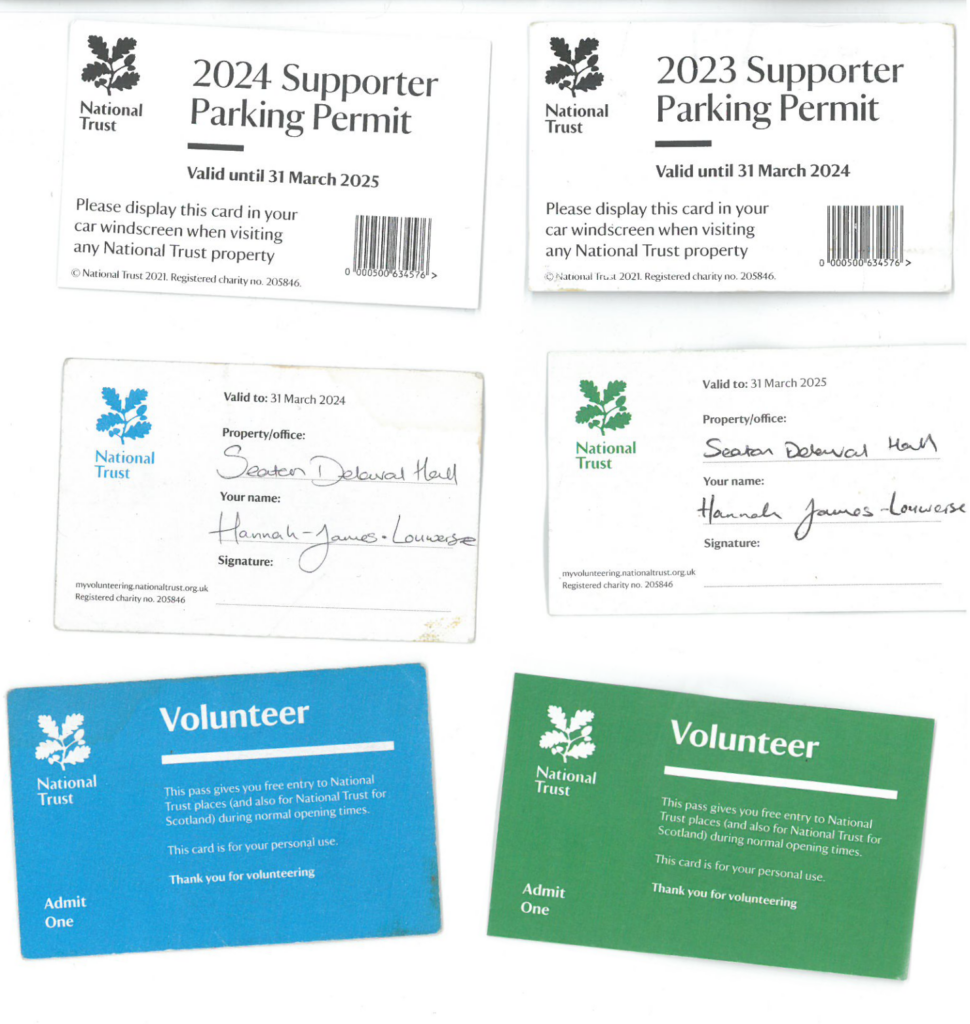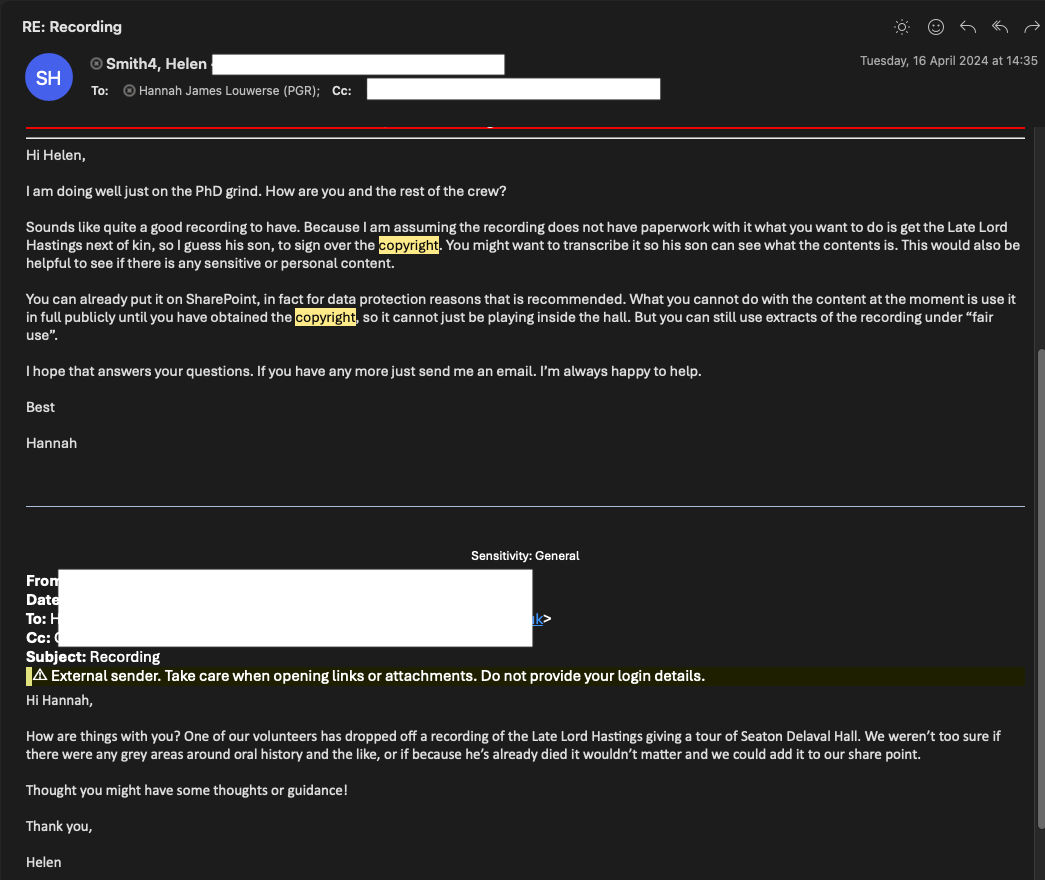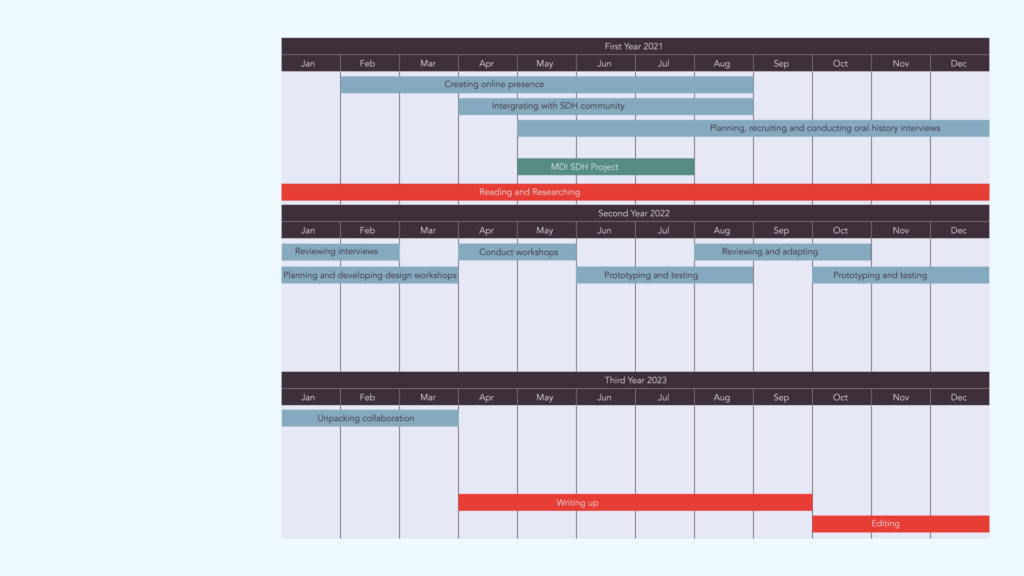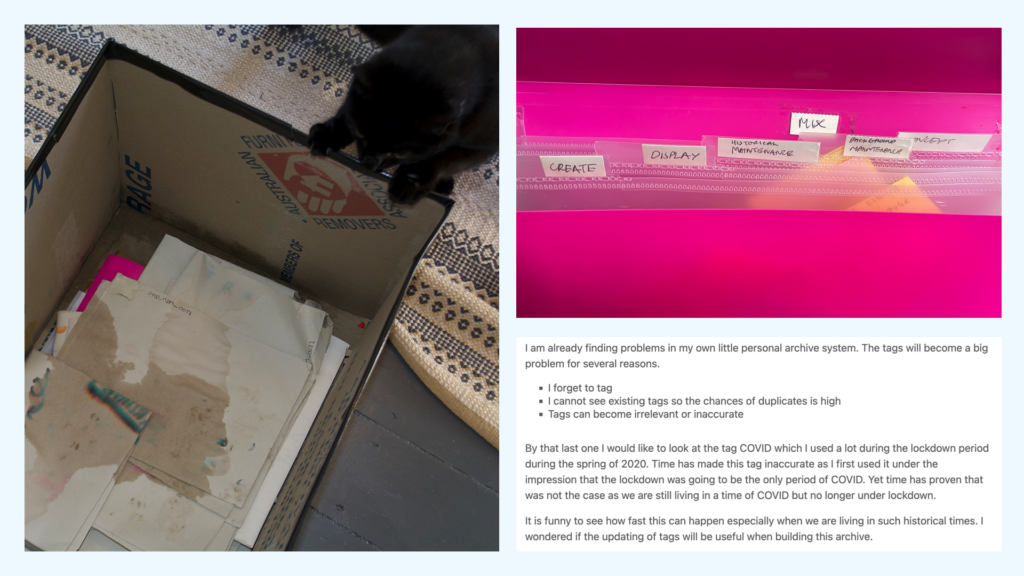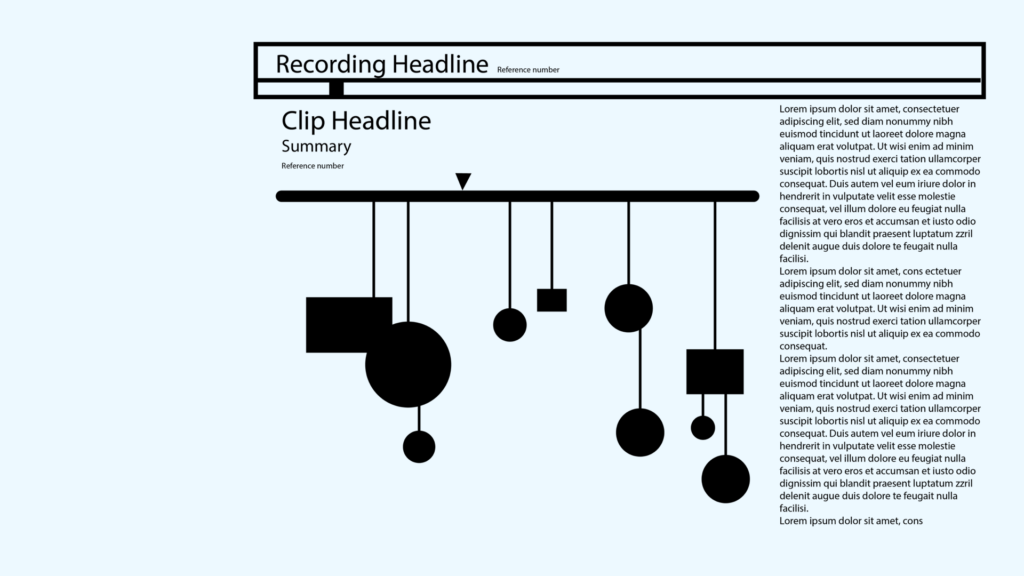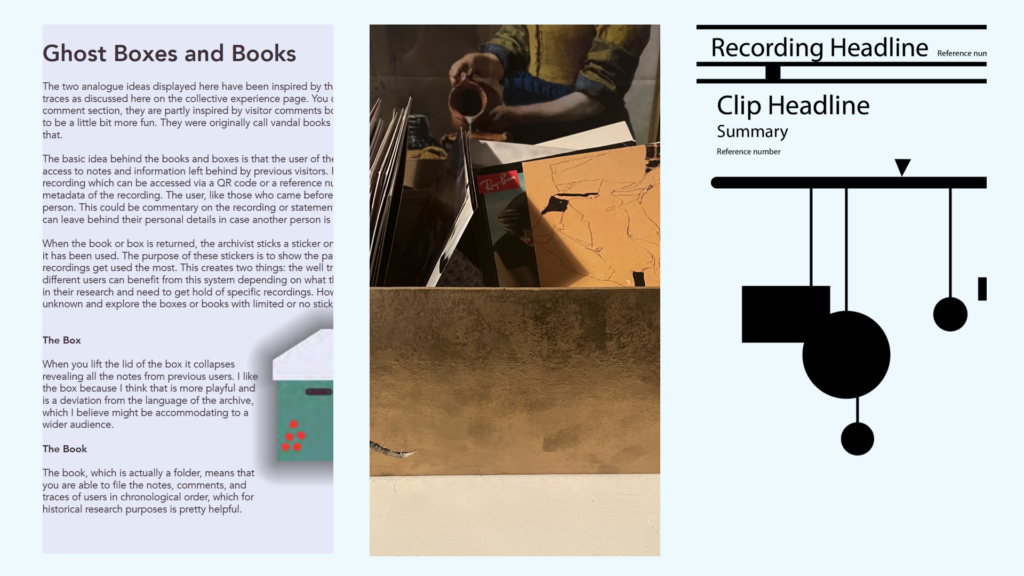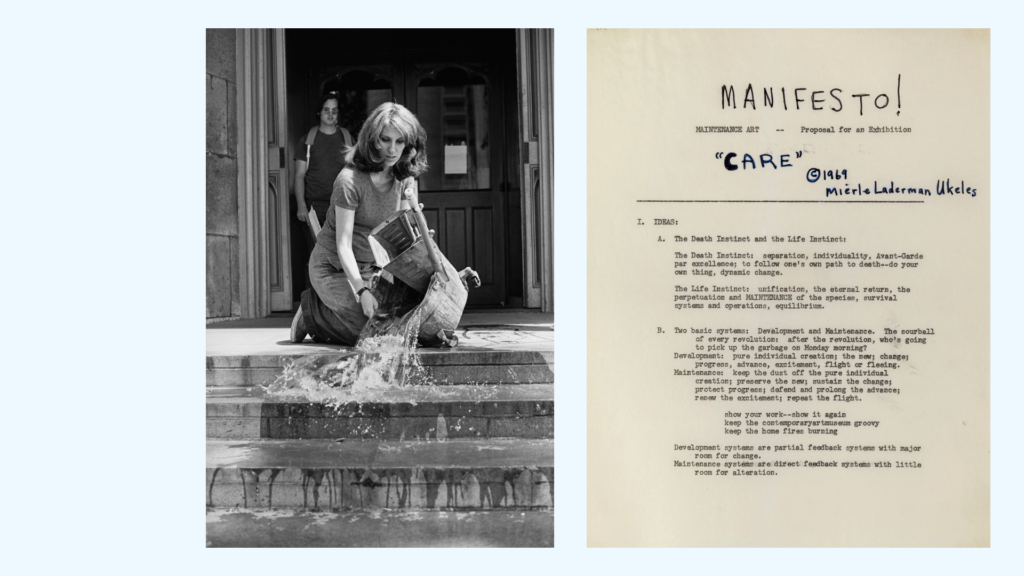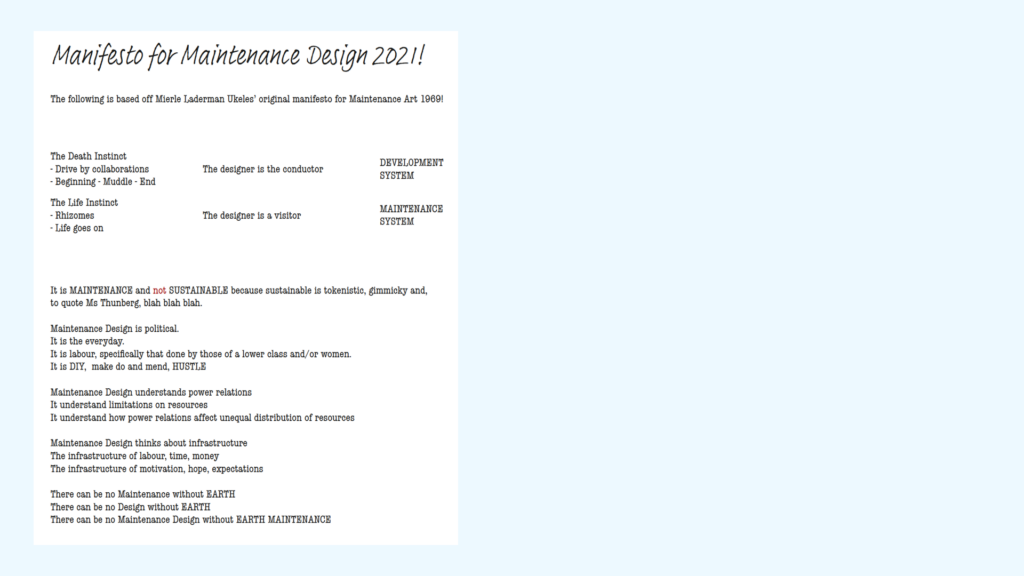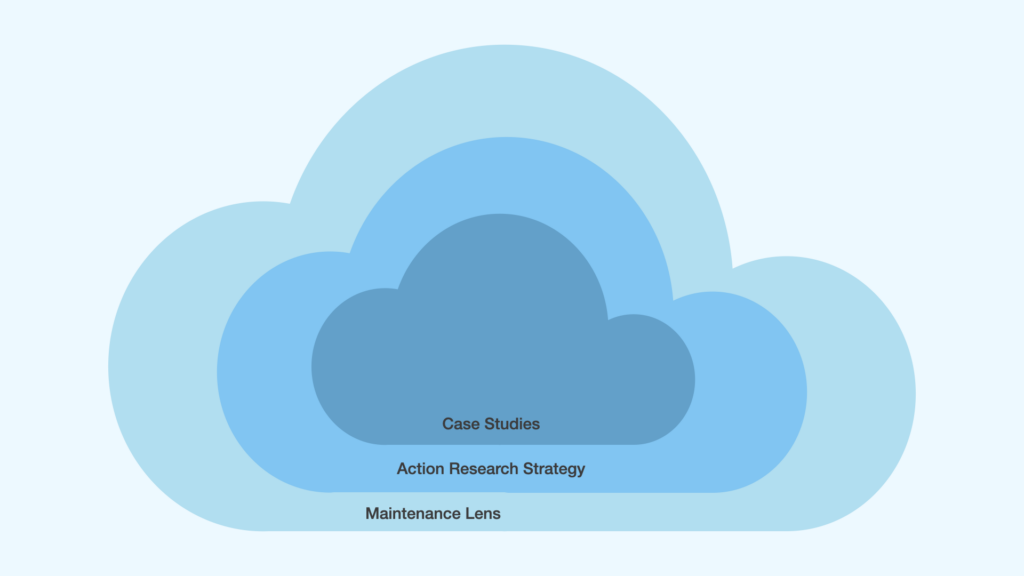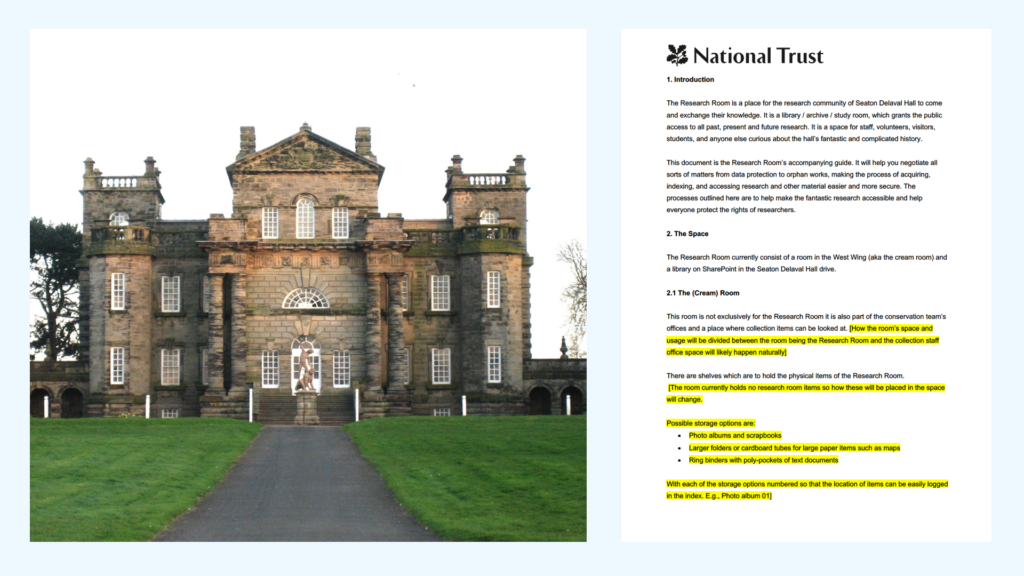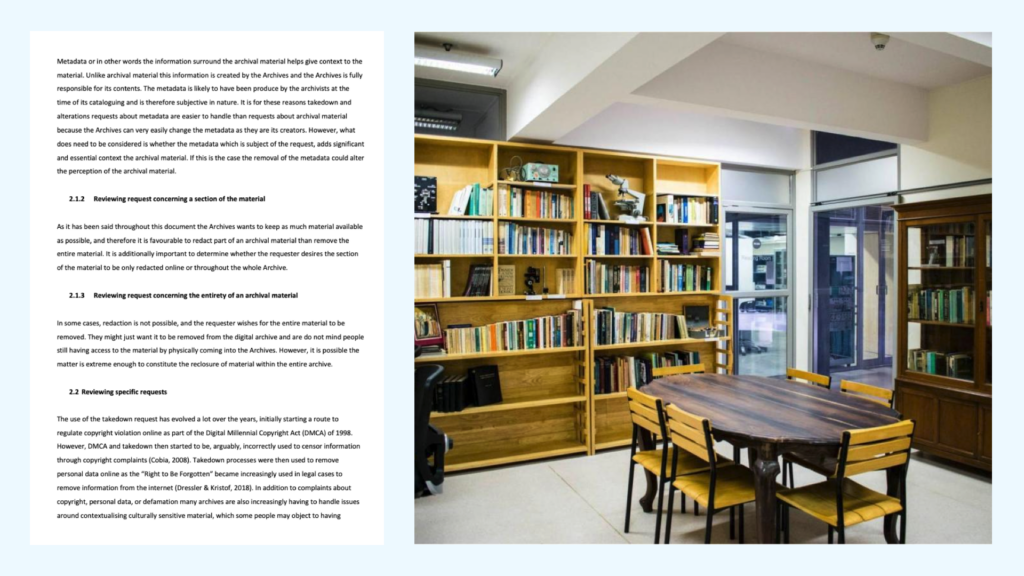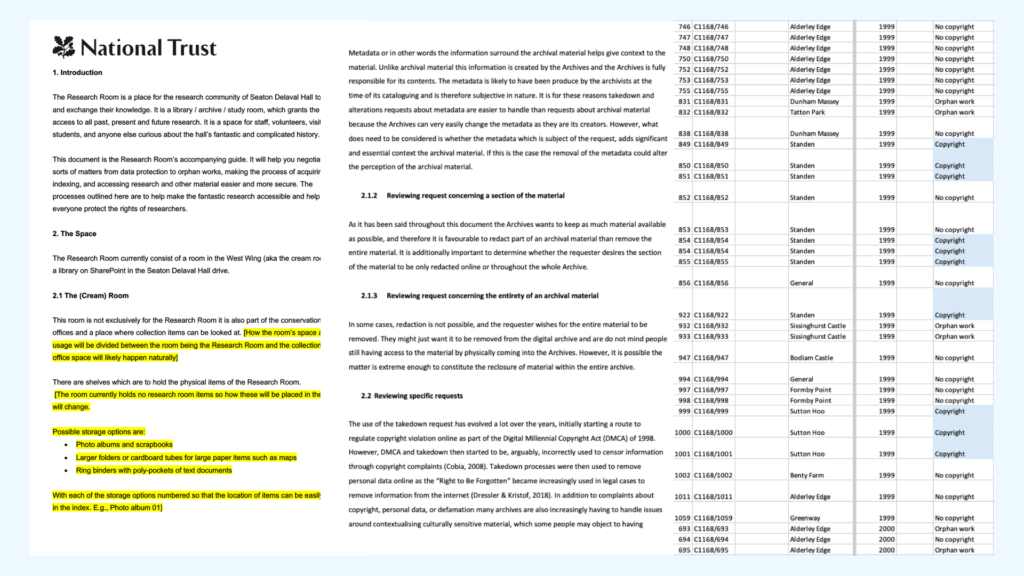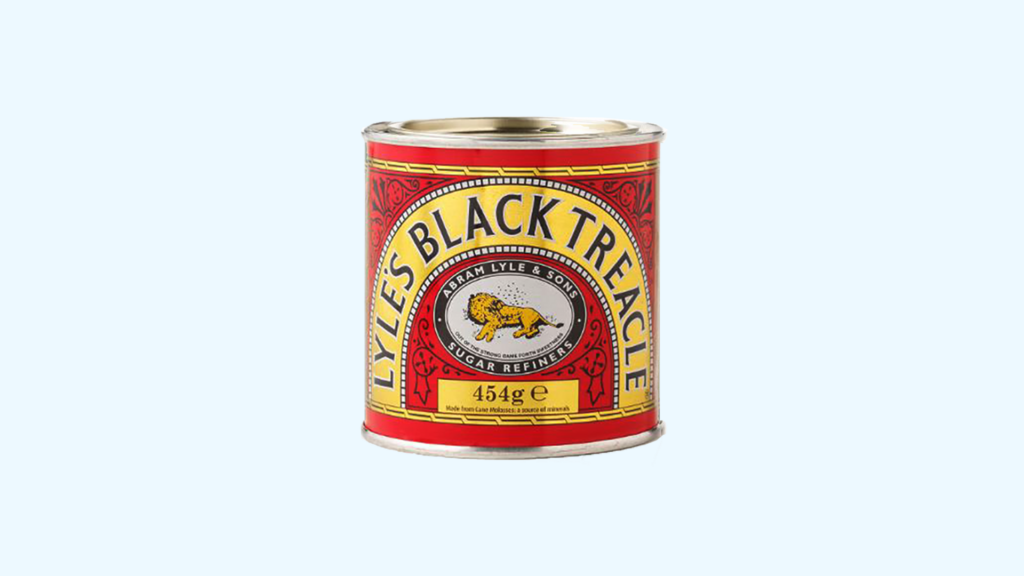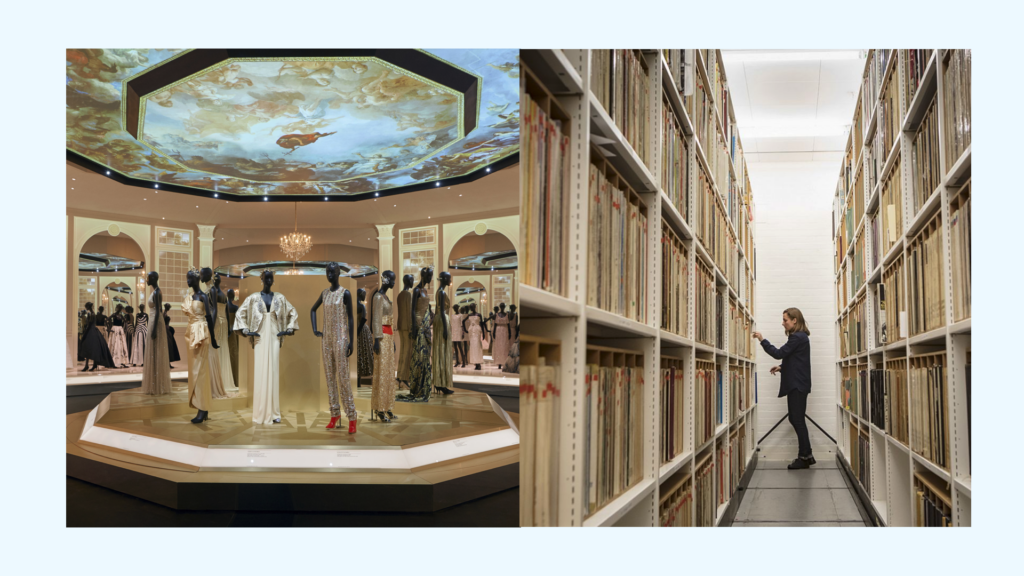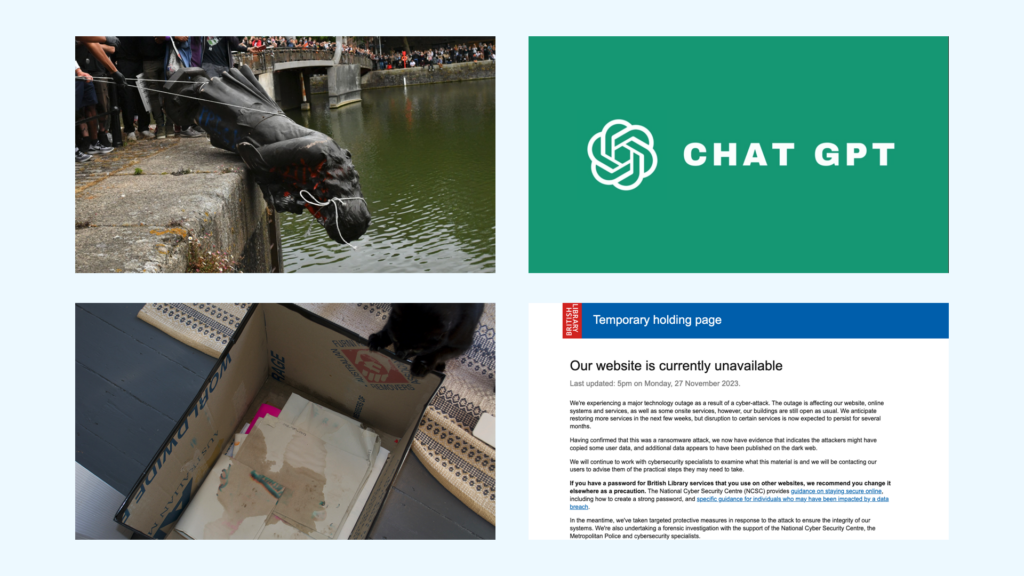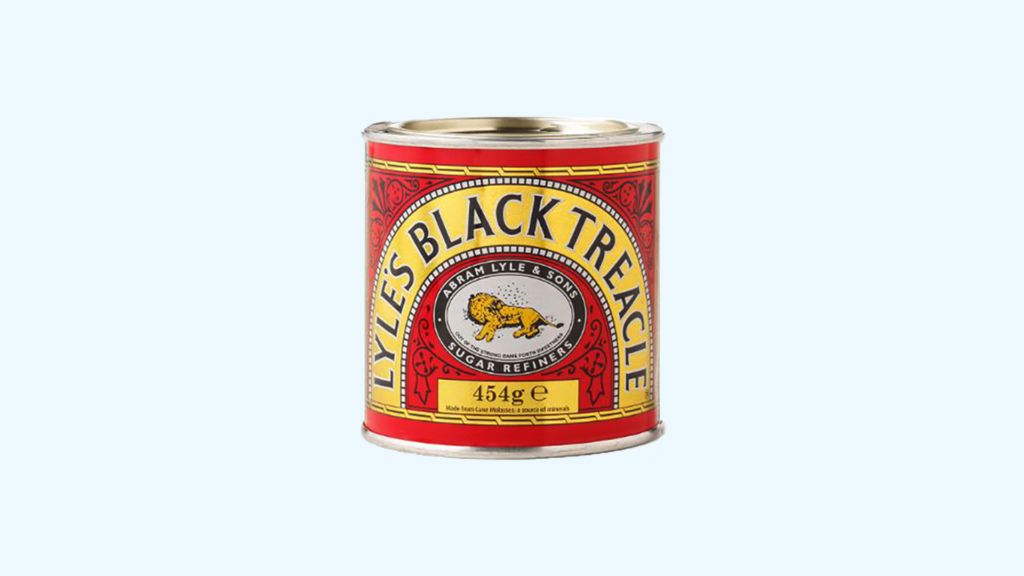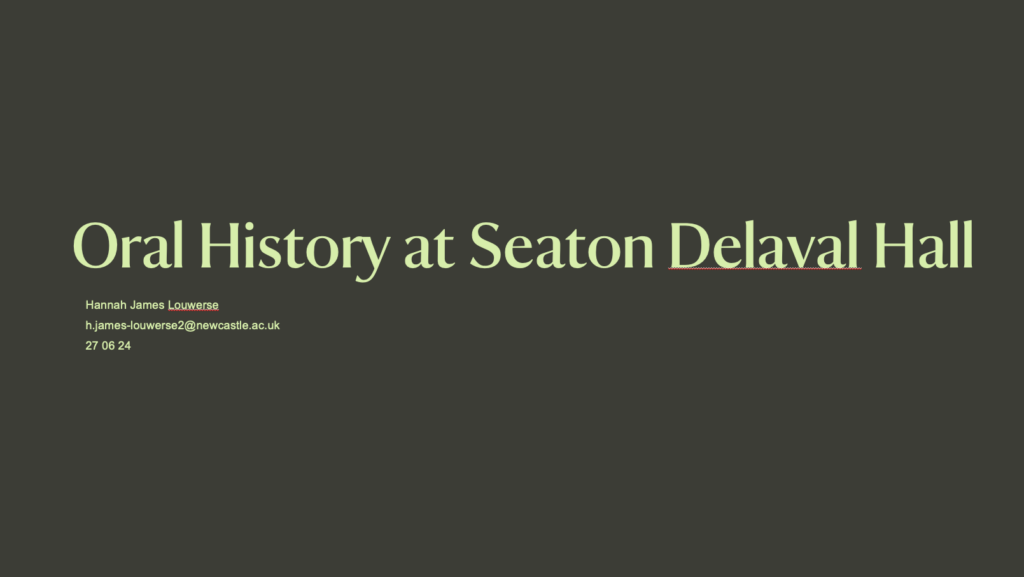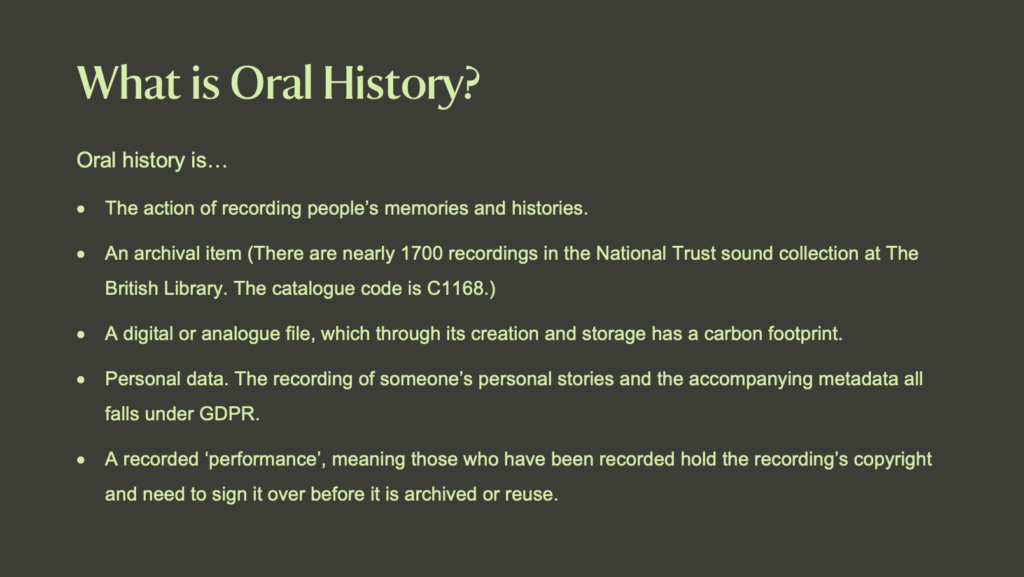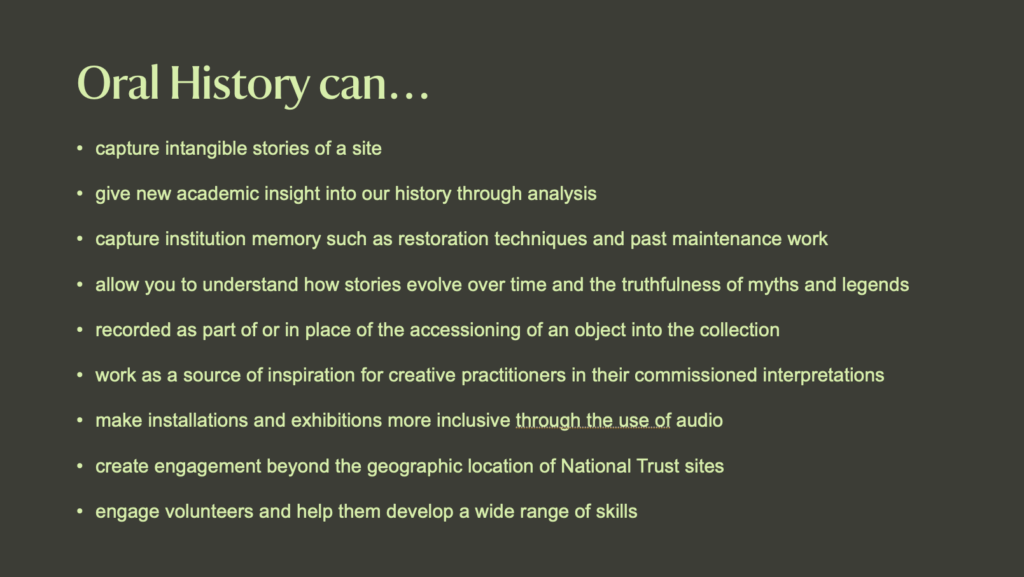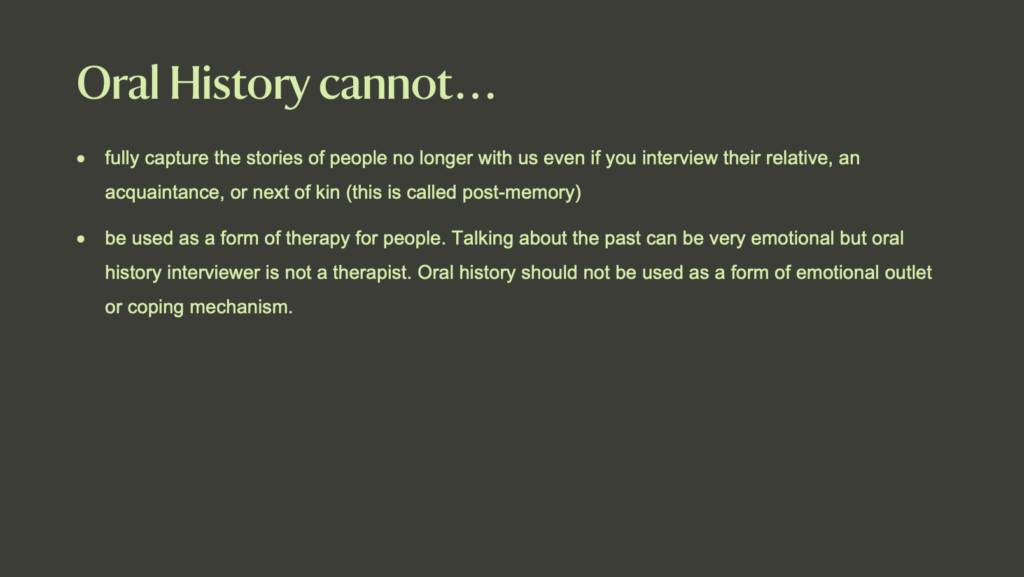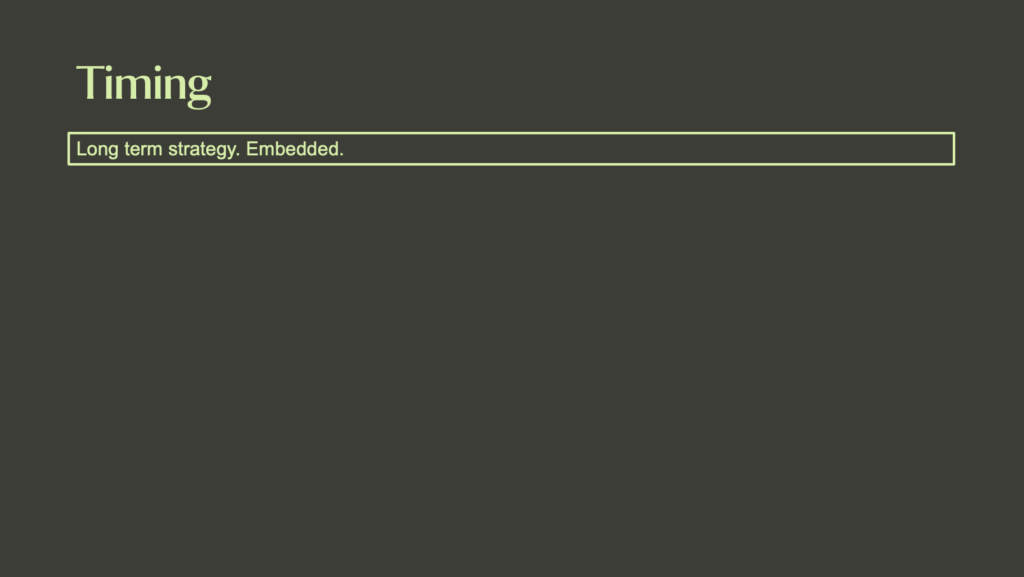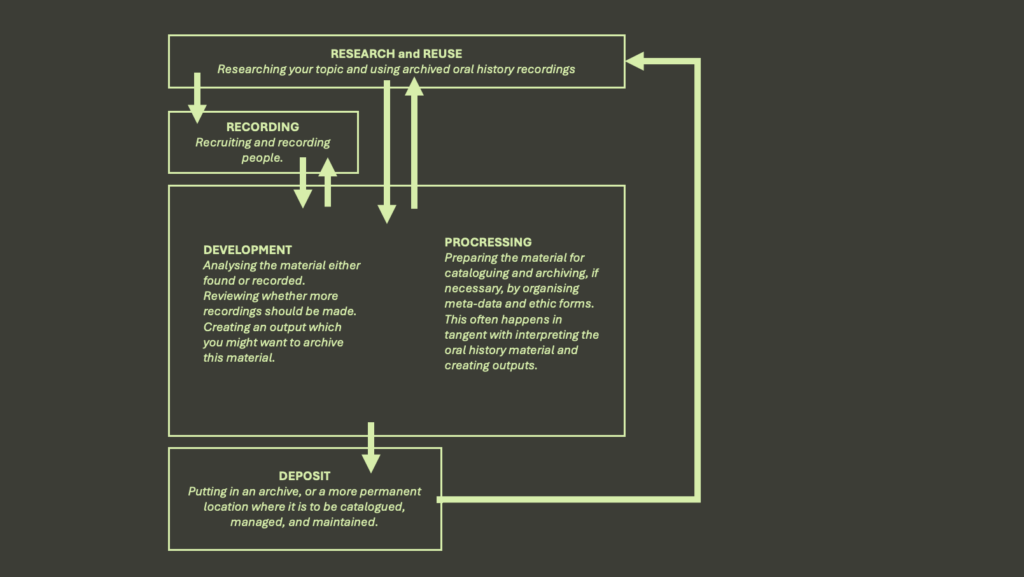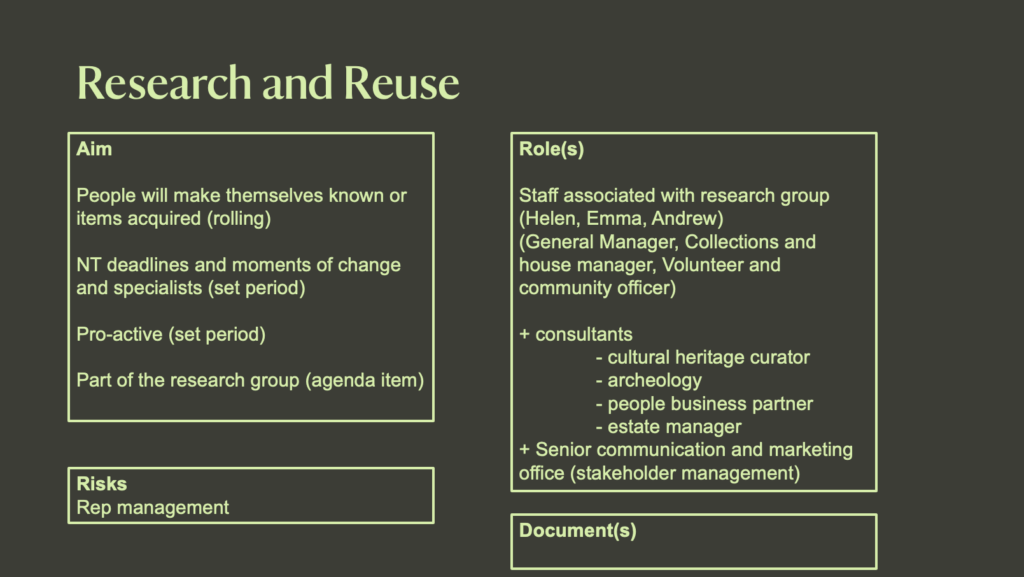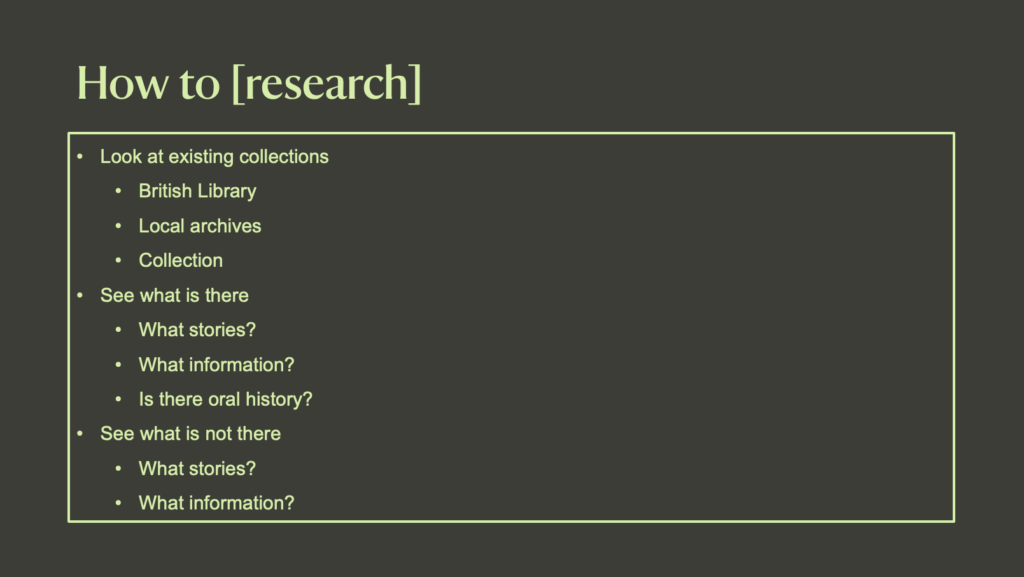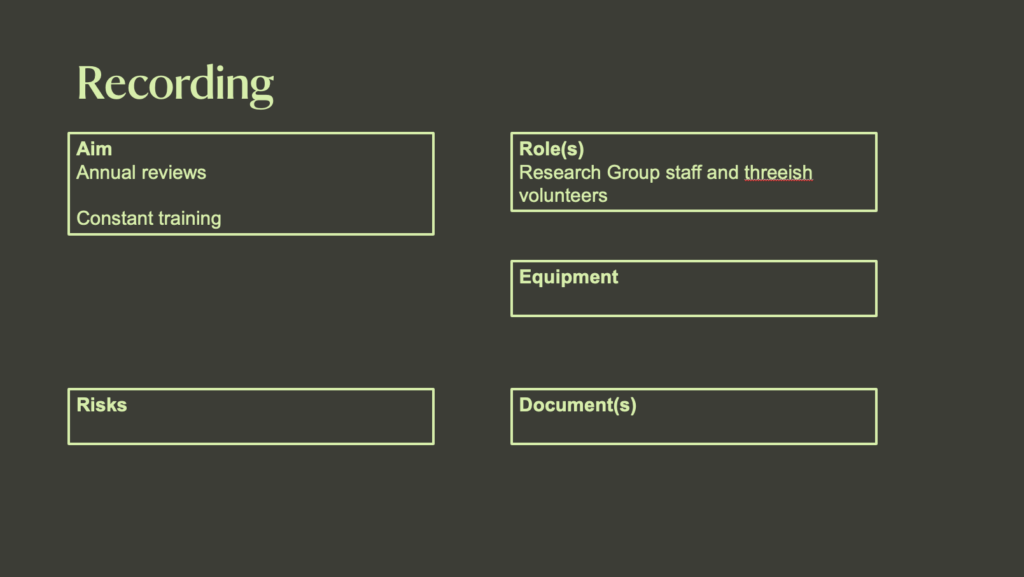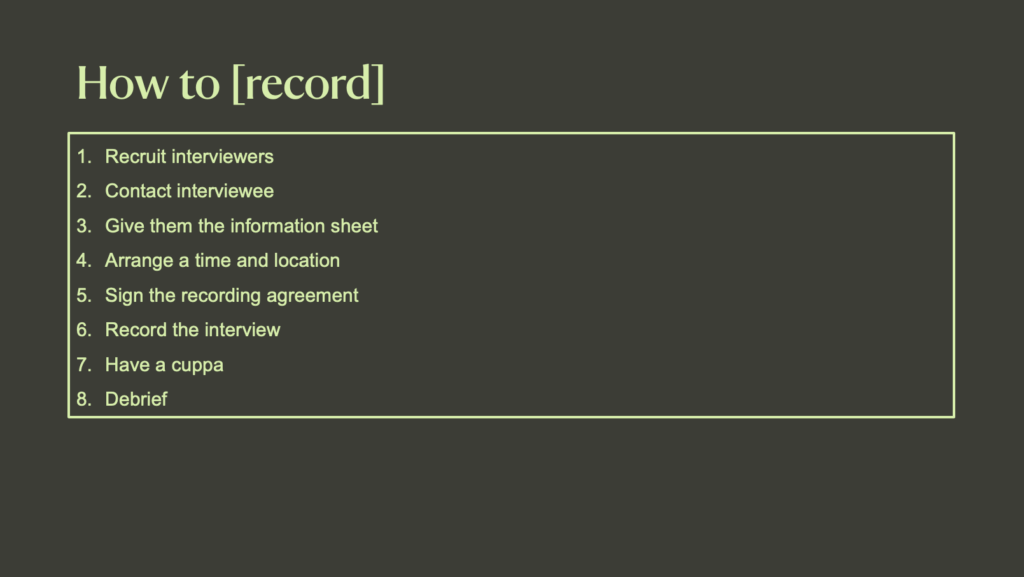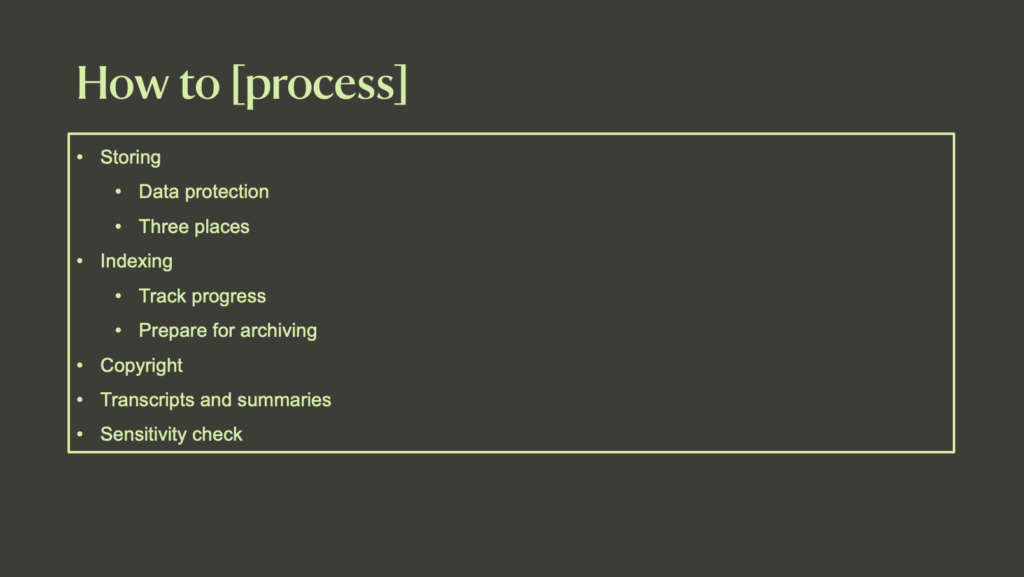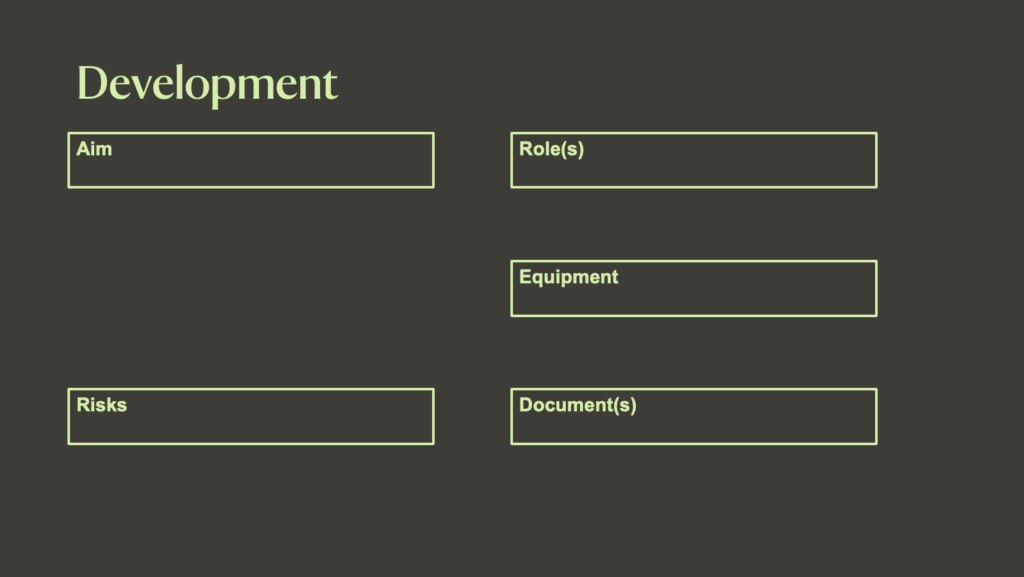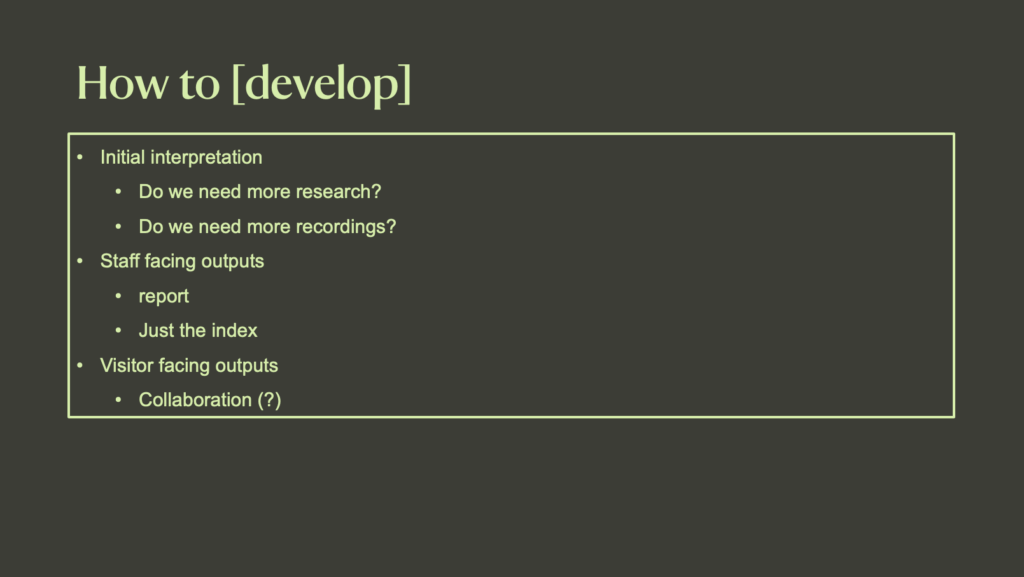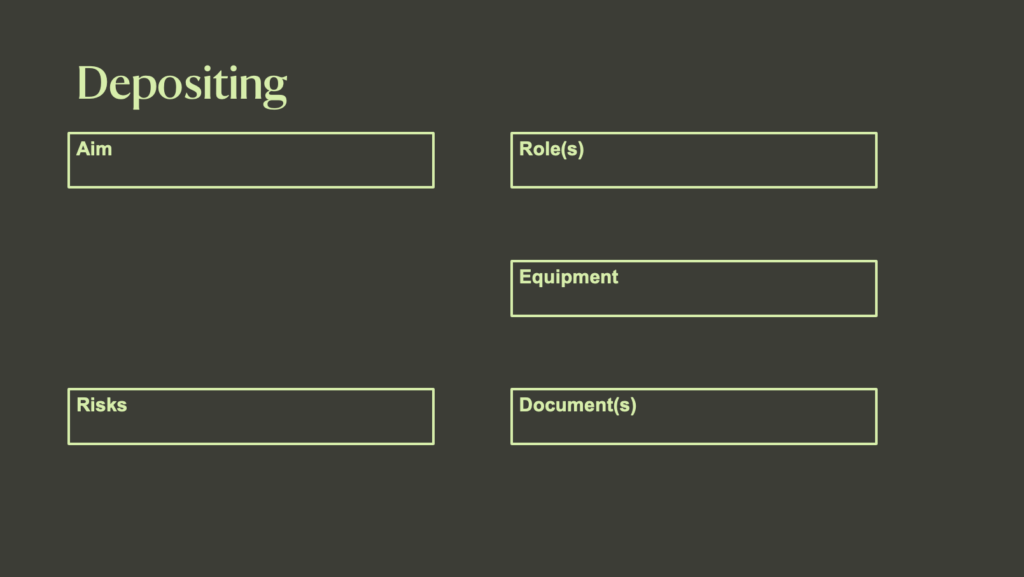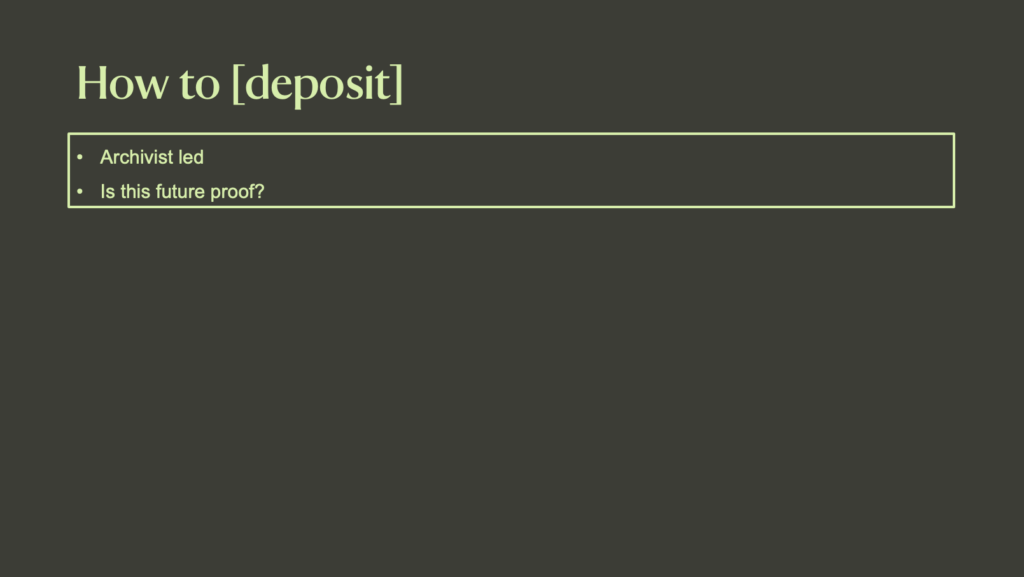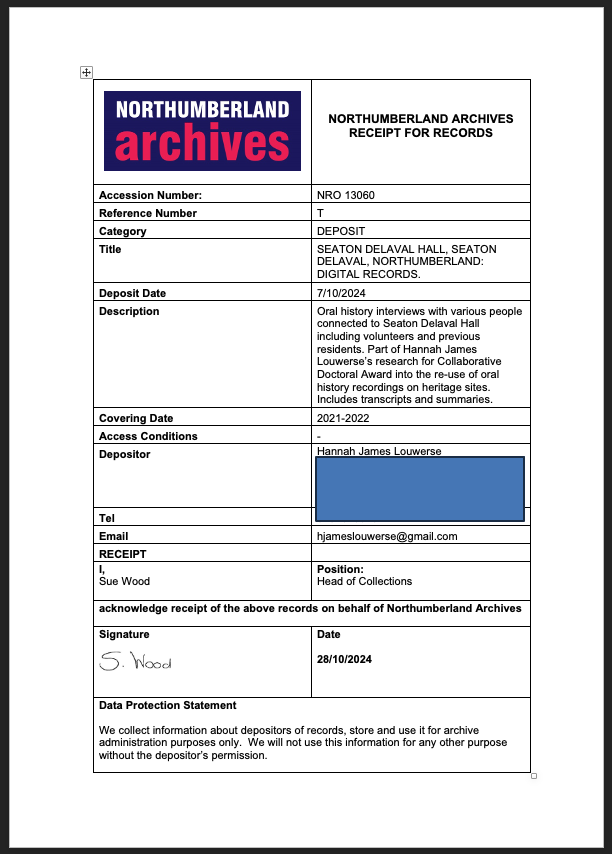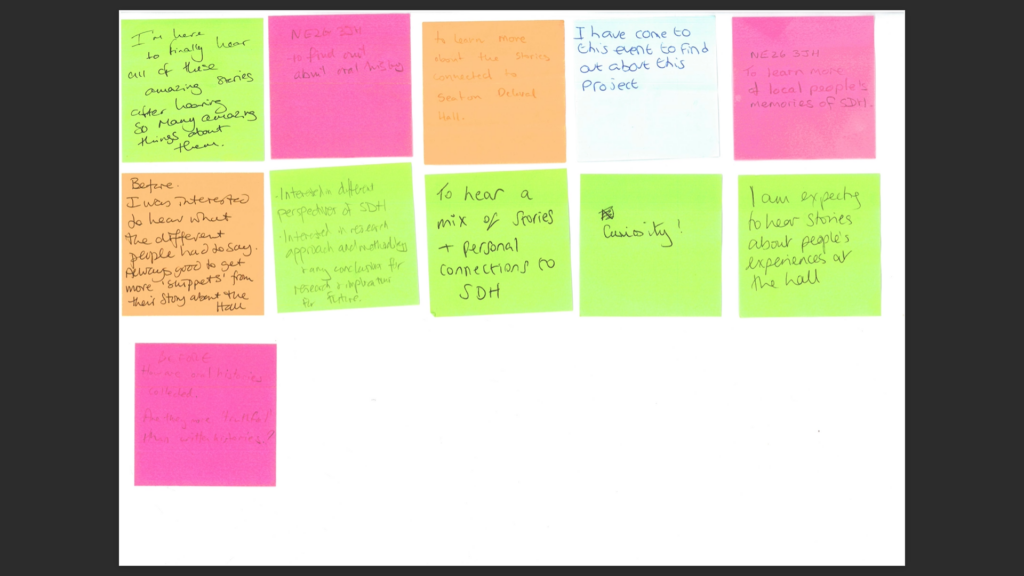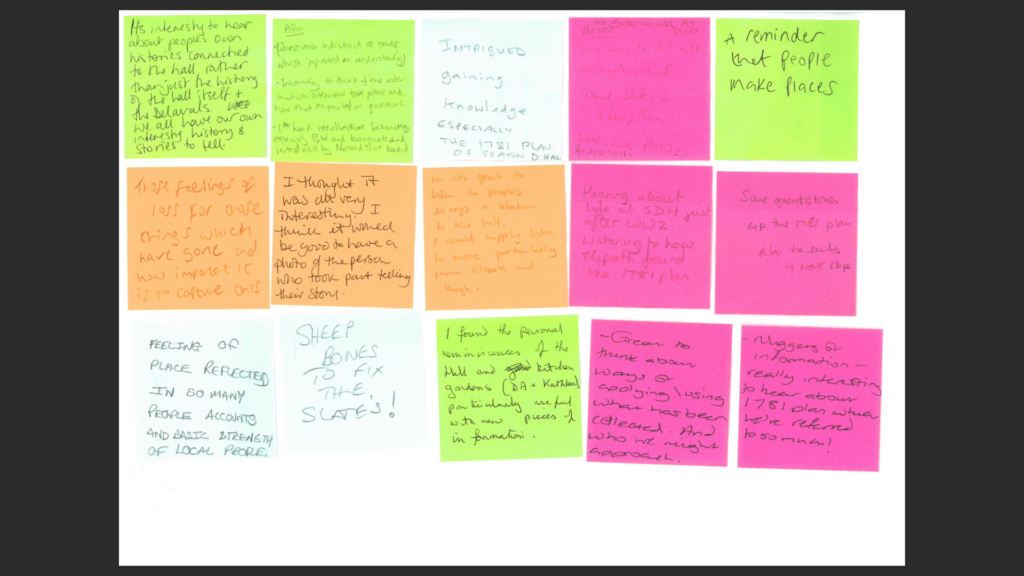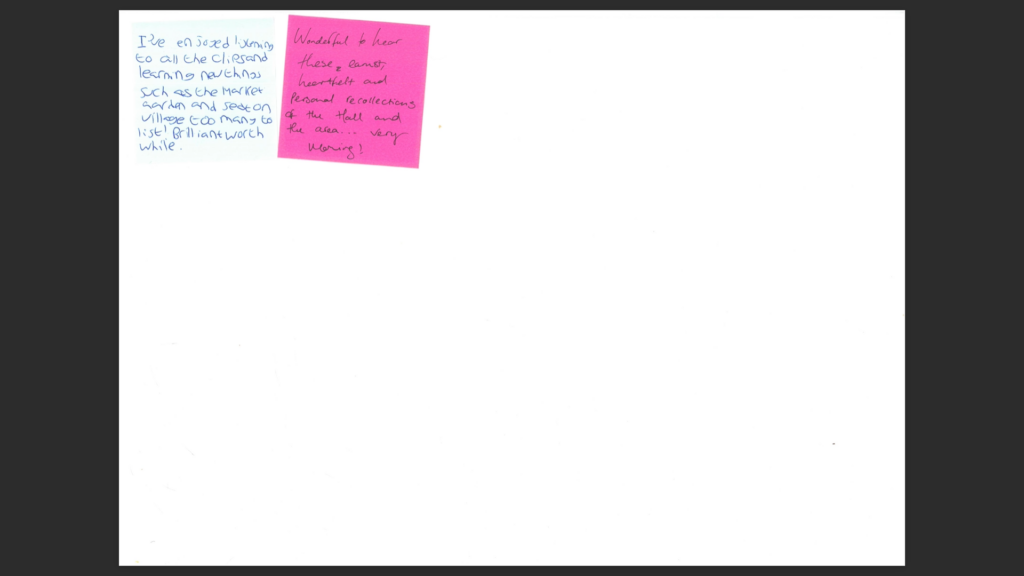Tag Archives: National Trust
OHD_FRM_0303 SDH OH questionnaire
OHD_SCP_0315 NT Volunteer memberships
OHD_SSH_0309 Email about copyright
OHD_AUD_0308 NT OH workshop audio
OHD_PRS_0301 Swimming through Treacle
So today im going to talk about designing in GLAM, by telling you about my experience designing in the national trust. Which I have illustrated with this can of treacle. And this is because one of my national trust supervisors described trying to basically get anything done in the trust as swimming through treacle. And it feels like it encapsulates my experience of designing in the trust.
//
To give you an idea of what I mean. I’ll show you my initial project plan I made right at the beginning of my phd.
So quick bit of CONTEXT my phd was developed off the back of the final project I did for my masters in multidisciplinary innovation. The task for the project was create an oral history project at Seaton Delaval hall and one of our conclusions was this archiving of oral history thing, you could make a phd out of it. And so we did. And I was going to look at creating something that specifically allow visitors to reuse oral histories on heritage sites. So in my mind this was likely to be some kind of sexy software that would just be so sleek and amazing that all oral histories problems would be solved. And this was my original plan on how I was going to do this is this. Now pretty much everything about this is wrong. Firstly because it is three years instead of four years, it does not include any of the placements I did. But also the entire process just did not or could not happen.
[UNPACK PROJECT PLAN]
I did realise that the usual iterative testing process is just not really possible because but I could never properly test them.
The only example I can give of iterative testing is with my own archive. But this has nothing to do with the working with GLAM bit.
I did give prototyping a try and although I did not test them.
However I thought the lack of testing told me a lot about the design environment.
I could not test the ghost boxes because they did not know what material to give me to test this with nor did they have the space for it, and most importantly they did not want to make any promises. The sound box could not be tested bc you are not allowed to have external tech in Nt and what oral history was I going to possibly use. The transcription ribbon was also one that could not tested because what laptop would that work on. So the lack of testing was not a complete failure in the end.
But I still need a new approach which I found after I looked at previous attempts at making oral histories more reusable. There have been a collection of attempts to make oral history more reusable. And most of them have failed ish. It is weirdly hard to do research into this because people did not really write a lot about when things failed. They publish papers on the super new tech and then they just disappear. Luckily there is one book that does talk about some failures. Boyd quote, VOAHA and stories matter
These all failed because people did not think about the maintenance of the work. And if we look at my prototypes you see the same issue. What these prototypes told me and the various attempts at making oral history more reusable. Was that it is not about what you make but about how you maintain it.
Which is how I get to Mierle Laderman Ukeles. Is a maintenance artist. She wrote a manifesto for maintenance art. Where she wrote the line “after the revolution who’s going to pick up the garbage Monday morning? I remember seeing her work during my time in art school and absolutely loving at the time but I had forgotten about it until it was mentioned by The British Library oral history archivist Charlie Morgan, who used this quote in a blog post about all the recordings that were made during the pandemic and how someone is going to have to archive these someone is going to have the clean up after the revolution.
So from this I wrote a manifesto for maintenance design, which I had totally forgotten I had written. So ukeles spilts the world into two systems in her manifesto the development system and the maintenance system, which she labels the death instinct and the life instinct. In terms of maintenance design I have put under the death instinct is that this is about drive by collaboration and the life instinct is simply life goes on. The designer is only a visitor to this space.
– labour
– limited resources (which also basically include labour. And I. Think that is also why I connected it to earth maintenance and looking after the planet)
So I decided to work through the lens of maintenance. but maintenance as a thing is really annoying because it is really hard to see if you are not part of it. IF you look t people who write about maintenance or infrastructure like Susan Leigh star a recurring theme is that you cannot see the value of maintenance until it breaks down. So my idea was that I would probably have to get very close to the situation in order to try and understand and map out the maintenance in these heritage sites, archives and look at how oral history needs to be maintained.
And this is how we get to Action research as a design strategy but while action research is normally the researcher going in and working with the stakeholders, but really what I did was work for the stakeholders. I literally went in and was like what do you want me to do. I have these skills how would like to use them. And so they would give me a task to do and then I would bring it back to them for feedback and they would yes no no no no yes maybe, not yet. In the reflective practitioner Schon compares being a reflective practitioner to what jazz musicians do, as they make it up and go with the flow. And that is very much what I had to do because no one tells what you need to know, either because they do not know or more often they simply do not have the time. I could have rocked up with my cute little sound box, they could not care less. They are thinking about the car park and whether the cafe has enough stock. You know how I found out the issues of IT at the national trust, my lovely supervisor was like you are tech could you sort this out and it was a nightmare. I then told the IT guy and he was like I’m gong to pretend I did not here you say that. You have to think on your feet the entire time and by working with or for them you can start building a better idea of the space you are designing in.
So action research was my strategy and under that came all these different case studies I was able bc my funding body is like go do placements. So what did I actually learn on these placements, well firstly my phd was going to be super unsexy.
– Seaton Delaval Hall:
research room design:
leaving room for change:
working with maintenance, leaving room for the stakeholders to make their own changes. It is about setting up a framework.
– NCBS: policy development: takedown policy and sensitivity check doc: have to really thorough think about what we mean by archiving: understand what GLAM does
– bl: audits: what can history tell us: working with change
So I learnt some good things while on these placements
– working with maintenance is allowing room for the existing structure to absorb your work by offering a framework not dictating a single solution.
– what GLAM does. It collects people’s property and thats complicated
– things changes and this effects how we maintain. So although I am focused on maintenance I also recognise that maintenance has to move with the times otherwise it breakdowns down and we working to restore not maintain.
But what do I say if someone comes up to me and is like “how do I design in GLAM?” How do I swim through the treacle?
Well I can tell you what GLAM does.
1. It collects peoples stuff. It collects people’s property. It might be something they own or something they made. and there are laws, ethics, and cultural customs that are around this you cannot forget. Also they might change and vary between countries.
It does two things with this stuff. It keep it and it curates it. how long something is kept can vary from whenever an exhibition is finished to forever either way however long it is kept it must be maintain and safe. How it curates it is also deeply political and never truly objective.
So if this is the why and what. The how is creating the balance between creation/collection/development and maintenance. Or more simply said Change and stability.
First It is about spreading the resources you have other these two spaces. NCBS
And the second is to one big ol’ theory of change or risk assessment.
OHD_DSN_0299 NT OH guide
OHD_RPT_0298 NT OH report
OHD_WKS_0297 SDH OH workshop
OHD_RPT_0296 SDH oral history strategy
Seaton Delaval Hall Oral History Strategy
V1
Hannah James Louwerse
1. Aim
The overall aim of the strategy is to embed oral history practices into the Hall’s existing research activities to create an ongoing process of collecting, interpreting, and sharing oral histories.
2. Roles
2.1 Core Oral History Team
The core oral history team consists of the General Manager, the Collections and House Manager, and the Volunteer and Community Officer. These members of staff already lead and support the volunteer Research Group. Their added responsibilities will encompass:
- setting up designated oral history training for volunteers and staff;
- organising the recording of new oral histories;
- recruiting volunteers for the recording and processing of oral histories;
- offering emotional support and guidance to the interviewers and transcribers.
In addition, this group will make up the reviewing team in charge of checking sensitive content in both the archived and newly recorded oral histories. They will also lead the oral history review which will take place annually during a Research Group meeting.
2.2 Supporting Site Staff
Although the Senior Communication and Marketing Officer is not part of the core oral history team, their contribution is essential for the successful implementation of the strategy. They will advise the core oral history team in matters related to the Hall’s reputation and data protection issues.
2.3 Supporting regional NT staff
Identifying and recruiting candidates for oral history interviews will require drawing on the expertise of regional National Trust staff, such as people business partners, estate managers and cultural heritage curators in, for example, archaeology.
2.4 Volunteers
Conducting interviews, managing data, and transcribing or summarising new oral histories will to a large extent be executed by NT volunteers. Equally, they will play a vital role in the researching of the archived oral history recordings.
3. Collecting oral histories
3.1 Scope and Focus
There are two forms of oral history which the Hall is aiming to collect:
- institutional memory
- histories of the cultural fabric of the Hall and the surrounding area
The recording accounts on the maintenance, restoration, and management of the site will help the Hall build an institutional memory. Collecting this information will create a collection of recordings which demonstrate the wide and diverse range of work done to preserve the site, its collection, and its history. It also avoids the loss of knowledge that occurs when an individual leaves the Hall. Histories of Seaton Delaval Hall’s cultural fabric will include recording information and stories about the collection, the hall, the gardens, and the surrounding area etc.
3.2 Pro-active Collection
The oral history is to be collected in a pro-active fashion, fully into the Hall’s knowledge gathering practices. Moments for potential collection are, for example, when a new item is acquired; as part of a research project; after restoration work; or when a significant person visits the Hall. More moments of collection will emerge as oral history gathering becomes a common practice on site.
4. Recording and processing oral histories
4.1 Training
A handful of staff and volunteers can be trained in oral history interview techniques, processing the recordings, and analysing the oral history material. Training sessions should be arranged at regular intervals, e.g., every three years. An analysis of training needs and requirements will be reviewed annually during a Research Group meeting. The training can be done through the oral history society or through Northumberland Archives.
4.2 Interim Storage
An interim storage solution needs to be arranged with the IT Department and Data Protection Office. Both have specific requirements for digital devices and Microsoft SharePoint.[1] In addition, there are restrictions on what external devices can and cannot be connected to Trust computers. Until a solution has been arranged, it is best to follow two main principles of digital storage: keep the recordings in three different locations and ensure those locations follow data protection law.
4.2.1 List of stored material
All material listed here contains personal information.
- Audio files (a WAV copy and a MP3 copy)
- Interviewee data sheets
- Recording permission forms
- Copyright and reuse forms
- Summaries and/or transcripts
- The Seaton Delaval Hall oral history catalogue
4.3 Ethics
4.3.1 Paperwork
There are two ethics forms necessary to collect and archive an oral history recording:
- a Recording Permission Form
- a Copyright and Reuse Form
The Permission Form must be signed before the recording device is switched on. The Copyright and Reuse Form is signed after the interviewee has read the transcript/summary of their recording or has listening back to the audio. The Copyright and Reuse Form allows the interviewee to close all or part of the recording for a set amount of time. Note that both forms contain personal information and therefore need to be stored in adherence with data protection law.
4.3.2 Sensitivity checks
Sensitivity checks are the responsibility of the core oral history team. They will read or listen to the oral histories and assess whether there is any sensitive content. Sensitive content comes in two forms:
- information the interviewee might not want out in the public domain
- information that could upset the listener of the recording
If the former is flagged by the core oral history team because they believe the interviewee might not want to share particularly information publicly, they should mention this to the interviewee before they sign the Copyright and Reuse Form. This may result in the interviewee wanting to close a particular section of the recording. If the team finds material which fits the latter, any sensitivity warnings should be added to the index.
4.4 Indexing
The spreadsheet created for indexing the Hall’s oral history recordings allows for easy tracking of progress and searching. It is also compatible with the British Library’s method of cataloguing in case the recordings are at some point donated to the British Library. The index contains personal information and therefore needs to be stored according to data protection law.
4.5 Transcripts and Summaries
The strategic aim is to create both a transcript and a summary for each oral history recording. Transcripts are essential if the audio file is lost or is corrupted. Interview summaries allow for content to be described in more searchable terms.
5. Archiving
Oral history recordings can be archived at Northumberland Archives. However, backup copies should be kept at the Hall in case the recording is also archived at the British Library. This is especially crucial since Northumberland Archives only excepts MP3 files and the British Library requires WAV files.
6. Reusing oral histories
In connection with the Hall and the collection, oral history can be used in interpretations and exhibitions. In addition, new staff or contractors can access the hall’s institutional memory and learn about their predecessors and their work by listening to the stories shared. The overall objective is for oral history to be a fully integrated and accessible resource, equally available for consultation as any item in the collection.
[1] For example, the IT department does not want WAV files to be put on SharePoint because they are very large, while the Data Protection Office requires all personal data to be stored on SharePoint.
OHD_AUD_0295 Listening session audios
OHD_RCP_0293 Receipt of deposit
OHD_SSH_0292 Screenshots of NT IT incidents
OHD_COL_0291 Collection of preinterview stuff
OHD_FRM_0290 Final copyright form
OHD_PST_0289 Feedback from listening session
OHD_COL_0279 JAN CRIT PLAN ETC
Plan for January conference/crit day – Version One
The day has been split into two halves. The first half will be more orientated towards the National Trust and any other public history institutions, while the second half is more focused on how to innovate and design solutions for maintaining archives. Both sessions will be online and will be recorded. I will also use a virtual whiteboard to document ideas, questions, and thoughts from the participants.
Morning Session – Oral history at the National Trust
Aim:
The general aim of this session to inform participants on the current status of oral history at the National Trust and to get feedback on some of my work which illustrates the various elements of oral history maintenance and see how this may translate over to the collection processes and policy at the National Trust.
Starting activity:
Everyone is asked to write down what they think oral history is.
Part one: Oral history at the National Trust up to now
In the first part of the session we will look at the current situation of oral history at the National Trust, starting with asking the group if anyone has done or has knowledge of any oral history projects done by National Trust sites. This will be followed by me giving brief history of oral history at the National Trust and information on the National Trust sound collection at The British Library. With permission from The British Library I would like to share the spreadsheet I made during my placement and get small groups to explore the catalogue for a couple minutes. We will then end this part of the morning with a quick “brain dump” where any thoughts, questions, ideas are shared with the wider group.
Part two: The future of Oral History at the National Trust
The second part of the sessions starts with me sharing my general breakdown of what is required to maintain an oral history recording. After this the larger group is split into smaller groups again and they are asked to think how this might work within the context of the National Trust. To give the groups a bit of structure they are encouraged to think of the 5 Ws and 1 H questions (Who, What, When, Where, Why, and How), then think how they might answer these questions.
Ending activity:
Everyone is asked again to write down what they think oral history is.
Afternoon Session – Innovation and design in archives
Aim:
The aim of this session is for me to share my experience and ideas of designing in archives.
The group will think about what it means for designers to work in archives but also what we mean by a “successful” or “good” archive.
Starting activity:
Everyone is asked to write down what they think an archive is.
Part One: What we learn from designer in archives?
In the first part of the session the participants are split into smaller groups which are a mixture between archivists and designers. Each group is given a scenario about maintaining access to oral history. They are then asked to think about what they would do in this particular scenario and as a group have to come with a plan. The plans are then shared in the larger group. They then go back into their smaller groups and are asked to think about whether the designers or archivists learnt anything from each other. After the smaller groups feedback again, I briefly talk about my experience of being a designer working in archives, specifically my thoughts on design and maintenance.
Part Two: What is a good archive?
Leading on from my thoughts on maintenance and design, the group is task with critically thinking what success looks like within archives. The group is first asked what they write what they think the value of archives is and are then given another scenario to discuss in their smaller groups. The scenario they are given is a world where everything can be kept and is accessible, all issues around digital obsolescence, copyright and data protection have been solved, but the climate crisis is threatening the stability of the storage systems, decay, and destruction of original material is inevitable. To give the groups some structure they are given a concepts and ideas matrix to sort their thoughts. After coming together as a big group again and feed backing, the whole group is asked whether the ideas and concepts they came up with reflect what they believe the value of archival material is.
Ending activity:
Everyone again writes what they think an archive is.
Version 2
Introduction to my PhD (General) – 15 mins
Story of the current collection PLUS values – 10 mins
Q and A – 5 mins to 10 mins
What value can oral history recordings give to the collections on sites? – 20 mins
Feedback – 10 mins
—————————————————— BREAK 5 mins
Issues with archiving and storing of OH at NT – 10 mins
Q and A – 5 mins to 10 mins
What resources do we need to make the flow from recording to archived easier? – 20 mins
Feedback – 10 mins
________________________________________ BREAK 5 mins
Legacy and knowledge transfer – 5 mins
Q and A – 5 mins to 10 mins
How do we make it easier to reuse oral history recordings? – 20 mins
Feedback – 10 mins
__________________________
Wrap up and thanks – 10 mins
Close
Workshop Blurb
A look into Oral History at the National Trust
Wednesday 31st Jan 2024
14:00 – 17:00
Online
This workshop is a culmination of three years of research into the past, present, and future of Oral History at the National Trust. It will take you through the stories found in the sound collection of 1700 recordings archived at The British Library, and the experience of recording Oral History on a National Trust site today. It will also offer insight into the opportunities and obstacles of recording future Oral History at the National Trust. The workshop aims to create a discourse around the rich, yet awkward resource of Oral History, how it can enrich the stories told by the National Trust, and the practical side of recording, archiving, and using such a personal artefact.
Hannah James Louwerse is completing her Collaborative Doctoral Award at Newcastle University. Her project is partnered with Seaton Delaval Hall where she has recorded oral histories from the community. She also completed a placement at The British Library auditing the National Trust’s large sound collection.
OHD_WRT_0276 C1168 uncatalogued items
Tranche 10 [G: Drive]
Property: Batemans
Folder contains:
One spreadsheet – which indicates four recordings on CDs transferred from mini disc
Four PDFs – scans of permission forms, summary, transcript and additional material
Property: Mottisfont (and Stockbridge?)
Folder contains:
One spreadsheet – which has 7 entries but only three are fully described. The NT reference is NT10678. There is also an additional sheet in the document for “Stockbridge” which has one entry with the NT code NT10924-001
Three word documents – summaries for interview with Derek Hill (NT reference NT10678-002), Prof. Rosalind Hill (NT10924-001, the Stockbridge one) and an BBC interview with Derek Hill (NT10678-004)
Property: Mottistone
Folder contains:
One spreadsheet – single entry NT10679
Tranche 11 (Knole) [G: Drive]
Property: Knole
Folder contains:
A single spreadsheet with 73 entries
C1168 Tranche 11 [N: Drive]
Property: Knole
Folder contains:
73 folders – each folder corresponds to an entry in the spreadsheet on the G: Drive folder “Tranche 11 (Knole). Each folder generally contains consent form, interview data sheet, timed content summary and the audio recording
Tranche 12 (Southwell) [G: Drive]
Property: Southwell
Folder contains:
One folder with 95 copyright forms and a spreadsheet of oral history interview metadata with 77 entries. The difference in the total of copyright forms to spreadsheet entries is likely due to some recordings having two or more interviewees. However the reference numbers for the recordings also seem to skip between NT10985—058 and NT10985—072 which could suggest files are missing although this is complete speculation. There are two entries for Brian Kay but this seems to be a mistake and one should be Paula Clifford. For nine of the entries I had not been able to locate any files these are:
Adkin, Margaret
Bowler, David
Cotterill, L
Gaunt, William
Knobham, Lily
Pitchford Diana
Ryan, Wendy
Thomas, Doris
Wright, Frederick
C1168 Tranche 12 [N: Drive]
Property: Southwell
Folder contains:
“OneDrive_1_05-10-2020” – the interviews on ten interviewees, one has an interview summary and the other seems to have additional written material. Two only have mp3s files. None of these names are found in the spreadsheet in the folder “Tranche 12 (Southwell)” in the G: Drive but their copyright forms are in the folder “copyright assignment” in in the folder “Tranche 12 (Southwell)” in the G: Drive.
Adamson, Louise
Ball, Samantha
Grice, Irene
Hancock, Peter
Kemp, Trevor
Kent, Pauline
Manning, Michael
Nicholls, Angela
Powell, Rosemary
Williamson, Neil
“OneDrive_1_25-09-2020” – 10 tapes with summary sheets in word doc format. Lynne Bush and Dorothy Bush are the same person. These are found in the spreadsheet in folder “Tranche 12 (Southwell)” in the G: Drive and their copyright forms are in the folder “copyright assignment” in in the folder “Tranche 12 (Southwell)” in the G: Drive.
“OneDrive_2_25-09-2020” – 19 interviews with summaries and one extra summary sheet for Hughes, Daphne and Stanley. These are found in the spreadsheet in folder “Tranche 12 (Southwell)” in the G: Drive and their copyright forms are in the folder “copyright assignment” in in the folder “Tranche 12 (Southwell)” in the G: Drive.
“OneDrive_3_25-09-2020” – the audio for ten interviewees some do not have summary sheets and the is one lone summary sheet for Kay, Brian. These are found in the spreadsheet in folder “Tranche 12 (Southwell)” in the G: Drive and their copyright forms are in the folder “copyright assignment” in in the folder “Tranche 12 (Southwell)” in the G: Drive.
“OneDrive_4b_25-09-2020” – One interview in Mp3 format, 15 in WAV. Only six have summaries. These are found in the spreadsheet in folder “Tranche 12 (Southwell)” in the G: Drive and their copyright forms are in the folder “copyright assignment” in in the folder “Tranche 12 (Southwell)” in the G: Drive.
“OneDrive_5_27-09-2020” – 14 interviews no summary sheets. One additional document in PDF format. These are found in the spreadsheet in folder “Tranche 12 (Southwell)” in the G: Drive and their copyright forms are in the folder “copyright assignment” in in the folder “Tranche 12 (Southwell)” in the G: Drive.
C1168 Tranche 13 [N: Drive]
Property: Clumber Park
Folder contains:
Material from one interview with Peter Stevenson, including permission forms, transcript and WAV file
Cupbooard
Tranche 5
Properties: A lot
Box 1 – Contains loads of CDs which are also found in the folder “C1168 Tranche 5” on N: Drive. HAS BEEN CATALOGUED but the CDs have not been given BL catalogue codes.
Box 2 – Contains CDs of recordings which are also found in the folder “C1168 Tranche 5” on N: Drive. A USB with summary sheets which are also found in the folder “Tranche 5” on G: Drive. HAS BEEN CATALOGUED but the CDs have not been given BL catalogue codes. There is also a cheat sheet explaining some stranger donations.
6 Rogue CDs – Definitely from Tranche 5 but these have bee labelled with their BL catalogue code.
Tranche 12
FIVE INTERVIEWS IN TRANCHE 12 ARE ALSO IN TRANCHE 4 IN THE FOLDER “WORKHOUSE”
The names are: Curtis & Freeman, Pointon, Smith S, Bush, Green
Property: The Workhouse, Southwell
Harddrive – OneDrive dump same as in the folder “C1168 Tranche 12” [N: Drive]
Box 1 of mini discs – Five interview which have been digitised and can be found in “OneDrive_3_25-09-2020” in N: Drive. Interview with Brain Kay which does have a summary in N: Drive but no audio file. And an interview with Margaret Adkin which does not have any material on N: Drive. One disc has no label, one has “interview (2)” as label and the final one is a test disc.
Box 2 of mini discs – One mini disc possibly labeled Touley, Law (handwriting is hard to read). And two labeled “Wendy Ryan ?” Note: Wendy Ryan’s interview is not in N: Drive.
9 CDs – also found on N: Drive. One is labeled Barker but there are two Barker in the spreadsheet
25 cassettes – Cassette not ripped from mini discs. One is labeled Holmes but there are two people called Holmes in the spreadsheet.
20 cassettes ripped from 13 mini discs
Tranche 10
Property: Bateman’s, Mottisfont, Mottistone, Stockbridge
6 cassettes of 3 interviews
A memory stick which is labeled Tranche 4 but is not Tranche 4 or any other Tranche
OHD_RPT_0274 NT BL Report
OHD_RPT_0263 NT property recommendations for PhD placement
NT property recommendations for PhD placement
Hannah James Louwers
21 June 2023
Questions to ask
Would you have good access to the local people who might know of the interviewees?
Are you looking to show how NT should do oral history projects or how they should handle collections of older recordings stuck on shelves?
Properties
Alderley Edge Landscape
Location: Cheshire
Notes on property: They only have two full time rangers and it is a landscape property, not a house so it is unlikely they will have a collections team.
No. of recordings: 80
Main interviewers: John Ecclestone
Date of recordings: Late 1990s – early 2000s
Copyright statues: 17 recordings have copyright and there are a handful of orphan works. Copyright is confusing here, there seems to be focus on getting copyright from the interviewers.
Notes on recordings: Big project in collaboration with the Manchester Museum. There are also several lectures. It also has a website: Alderley Edge Landscape Project (derbyscc.org.uk)
Hannah’s recommendation: ⭐ ⭐ It is one of the biggest projects but because the property is unlikely to have a collections team, you will have no one to champion the work.
Attingham Park
Location: Shropshire
Notes on property: An 18th-century estate. Property ‘Trust’ property. BIG!
No. of recordings: 43
Main interviewers: Edward Payne, Michael Ford, John Ecclestone
Date of recordings: 1960s – 2000s
Copyright status: Half copyright, half not.
Notes on recordings: These recordings came in tranche 5, which was all CDs, many copied from original tapes. Note that some recordings in tranche 5 might be duplicates of recordings in tranche 1.
Hannah’s recommendation: ⭐ ⭐⭐ A lot of recordings taking over a very long period of time. I imagine this might be a difficult one.
Basildon Park
Location: Berkshire
Notes on property: Big 18-century estate. Very ‘Trust’
No. of recordings: 12
Main interviewers: Mary Turton
Date of recordings: 1980s – 2000s
Copyright status: Half have copyright, half does not
Notes on recordings: Many different interviewers
Hannah’s recommendation: ⭐ ⭐ ⭐ ⭐⭐ A small set of recording which might be more manageable for a three month project.
Biddulph Grange Gardens
Location: Straffordshire
Notes on property: It is a garden, so they are unlikely to have collection staff.
No. of recordings: 48
Main interviewers: John Ecclestone, Michael Ford, Bill Malecki
Date of recordings: 1980s – 2000s
Copyright status: 5 recordings have copyright and there are some orphan works
Notes on recordings: Bill Malecki is also the garden and was interviewed
Hannah’s recommendation: ⭐ ⭐ ⭐ This collection might be too big for the three month placement and I am not sure of the staff set up on site. You are likely to have to work with the regional curator.
Blicking Hall
Location: Norfolk
Notes on property: Jacobean mansion with big garden.
No. of recordings: 18
Main interviewer: Nick Ross
Date of recordings: 1980s, and one in 1990
Copyright status: One has copyright
Notes on recordings: Nick Ross did all his recordings in 1986-1987. There is one recording of 11th Marquis of Lothian which was recorded during WW2.
Hannah’s recommendation: ⭐ ⭐ ⭐ ⭐ Small collection but recorded a long time ago which might make things difficult.
Calke Abbey
Location: Derbyshire
Notes on property: Home and estate.
No. of recordings: 41
Main interviewers: Kerry Usher
Date of recordings: 1980s – 1990s (most are unknown)
Copyright status: Many have no accession form
Notes on recordings: Only five recordings were not recorded by Kerry Usher
Hannah’s recommendation: ⭐ ⭐ ⭐ ⭐ This one could be very easy if the property just forgot to give the copyright forms or it will be very difficult.
Clent Hills
Location: Worcestershire
Notes on property: It is a walking route and not an estate, so will not have a collection team
No. of recordings: 11
Main interviewers: Tamsin Mosse
Date of recordings: 2009-2010
Copyright status: One recording has copyright
Notes on recordings: These were recorded onto CDs from a Flash Memory Card by John Ecclestone in 2010
Hannah’s recommendation: ⭐ ⭐ ⭐ ⭐ A more recent one which might make things easier and make up for the fact it is a walking route and not an estate
Clumber Park
Location: Nottinghamshire
Notes on property: Park with a walled garden, a chapel, and ornamental bridge.
No. of recordings: 14
Main interviewers: Leah Lawman, Alistair McDougal
Date of recordings: 1990-91
Copyright status: No copyright at all
Notes on recordings: Classic project run in the early 1990s by the looks of it.
Hannah’s recommendation: ⭐⭐⭐ Could be a good case study because it is clearly a case of an oral history project, which is how many of the NT oral histories will be collected
Coughton Court
Location: Warwickshire
Notes on property: A tudor house in Warwickshire. Classic NT and probably very popular
No. of recordings: 13
Main interviewers: Michael Ford
Date of recordings: 1970s -1980s
Copyright status: One recording has copyright
Notes on recordings: This is a classic early oral history project for NT. Robin Bryer and Michael Ford did some of the earliest recordings for the Trust. Also this one is likely to have duplicates in tranche 5, because tranche 5 consists of CDs made from cassettes. I suspect BL might have some of the original cassettes.
Hannah’s recommendation: ⭐ ⭐ ⭐ ⭐⭐ It is a classic NT oral history project and will be a good example of how to handle material from project long gone by rather than be a good example of how to do contemporary projects.
Dudmaston
Location: Shropshire
Notes on property: Country house still lived in
No. of recordings: 14
Main interviewers: Bill Gatter, Jeremy Milln, Sarah Kay
Date of recordings: 1980s-2010s
Copyright status: No copyright
Notes on recordings: John Ecclestone worked as sound recordings on most interviews. Originally recorded on mini disc but the BL only has the CDS from tranche 5. (Yes, someone was recoding on mini disc in 2012).
Hannah’s recommendation: ⭐ ⭐ ⭐ ⭐⭐ It is a small collection recorded over a wide period of time and none have copyright.
Dunham Massey
Location: Cheshire
Notes on property: Garden, deer park, and a house
No. of recordings: 70
Main interviewers: Peter Lee, James Rothwell
Date of recordings: 1980s – 1990s
Copyright status: One big chunk does have copyright, another chuck have no accession forms, and there are some that have the reuse forms which do not include the word copyright.
Notes on recordings: Many different interviewers.
Hannah’s recommendation: ⭐ ⭐ ⭐⭐ Big collection with everything present but it might be too big for a three month project
Hardwick Hall
Location: Derbyshire
Notes on property: Classic ‘Trust’
No. of recordings: 25
Main interviewers: Tim Whittaker, Alistair McDougal
Date of recordings: 1980s-1990s
Copyright status: No copyright
Notes on recordings: Possibly two different oral history projects one in the 1980s and one in the 1990s
Hannah’s recommendation: ⭐ ⭐ ⭐ ⭐⭐ A classic Trust property with an average amount of recordings.
Monk’s House
Location: East Sussex
Notes on property: Leonard and Virginia Woolf’s 16th-century country retreat. Smaller property
No. of recordings: 12
Main interviewers: Patricia Tate, Malcolm Billings
Date of recordings: 1990s
Copyright status: No copyright
Notes on recordings: Patricia Tate is likely to have died or be over 100 years old. There are also a lot of radio recordings for this property
Hannah’s recommendation: ⭐ ⭐ ⭐ ⭐⭐ A smaller property and collection might be more manageable
Osterley Park
Location: London
Notes on property: House and parkland
No. of recordings: 18
Main interviewers: Jean Price, Gwyneth Learner, Lucy Tusa
Date of recordings: 1989 – 2000s
Copyright status: No copyright
Notes on recordings: Jean Price recorded in 1989, Gwyneth Learner in the 1990s and Lucy Tusa in the 2000s
Hannah’s recommendation: ⭐ ⭐ ⭐ ⭐⭐ A London based property might mean you are able to go and rummage around their cupboards for copyright forms. Also an average sized collection made of three bouts of recordings.
Powis Castle
Location: Powys, Wales
Notes on property: Medieval Castle (not very Trust)
No. of recordings: 21
Main interviewers: Michael Wynne Griffith
Dates of recordings: UNKNOWN
Copyright status: No copyright
Notes on recordings: A very messy collection. Many of the interviews do not have an interviewer noted in the catalogue
Hannah’s recommendation: ⭐ ⭐ A challenge
West Wycombe Village and Hill
Location: Buckinghamshire
Notes on property: Mansion and parkland
No. of recordings: 19
Main interviewers: Olga Macdonald, Alison and Peter Gieler
Dates of recordings: 1990s – 2010s
Copyright status: The more recent recordings one have copyright. The older ones recorded by Olga do not.
Notes on recordings: Olga was later interviewed in the more recent project. I suspect the more recent project was run by volunteers.
Hannah’s recommendation: ⭐ ⭐⭐⭐ The first project does not have copyright sorted but they clearly have sorted everything out for their more recent project. They might be easy to work with if they are familiar with oral history already.
